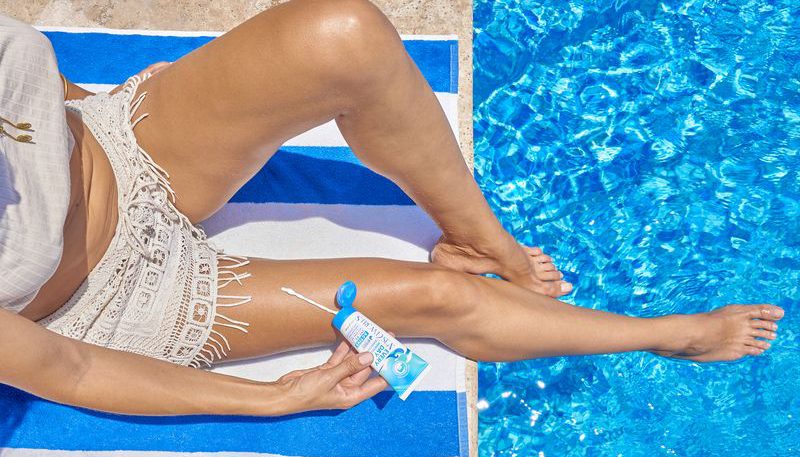WHAT YOU DON’T KNOW CAN HURT YOU — AND FUTURE GENERATIONS
As summer approaches and our thoughts turn to fun-filled days in the water, it’s important to consider the products we use to protect our families from the sun’s harmful rays. While sunscreen is a must-have for any pool or beach day, not all sunscreens are created equal.
Most commercial sunscreens contain petrochemicals like oxybenzone, avobenzone, and octinoxate, which are known to be harmful to marine life and can cause coral bleaching when washed off in the ocean. But did you know that these same chemicals can also react with chlorine in swimming pools to form toxic byproducts?

When chemical sunscreens come into contact with chlorine, they’ve been shown to break down and form compounds that can be extremely harmful. These byproducts, known as chlorinated organic compounds, have been linked to a range of health issues, including hormone disruption and even cancer.
The good news is that there are safe and effective alternatives to chemical sunscreens. Mineral sunscreens, like those offered by Stream2Sea, use coated and non-nano zinc oxide or titanium dioxide as their active ingredients. These minerals are not only gentle on the skin but also safe for the environment.
Craig Downs, Scientist – who led the team that published the landmark report on oxybenzone killing coral reefs in 2015 – hasn’t allowed his children in public swimming pools in years.
“The toxicity and pollution in swimming pools are much worse than what we see on coral reefs,” he said. “Not only are the sunscreen ingredients more concentrated, but the disinfectants that oxidize oxybenzone and avobenzone can increase their toxicity by 600% and more. These oxidized sunscreens are way more genotoxic, mutagenic, and carcinogenic.”
According to the most recent report published in the peer-reviewed journal Chemosphere, avobenzone broke down into a combination of aromatic acids, aldehydes, phenols, and acetyl benzenes, several of which are highly toxic.
“On the basis of these experiments, one could conclude that a generally safe compound transforms in the (pool) water and forms more dangerous products,” said Albert Lebedev, the study’s author. “In spite of the fact that there are no precise toxicological profiles for the most established products, it’s known that acetyl benzenes and phenols, especially chlorinated ones, are quite toxic.”
A similar report was published in the journal Environmental International identified more than 60 chemicals created as byproducts of avobenzone. “Although the toxicity of the majority of these products remains unknown, chlorinated phenols and acetophenones are known to be rather toxic,” the report notes.
“It’s certainly alarming,” University of Kansas dermatologist Daniel Ayers told the Kansas City Star. “(Avobenzone) can degrade into some very harmful compounds, some of which are known carcinogens. What isn’t known is how much is absorbed into the skin, or if it’s to a level that can cause, or potentially increase, the risk of cancer.”
Yet another study looks at how five chemical sunscreens – including oxybenzone, avobenzone, and octocrylene – break down in chlorinated seawater. Four of them formed bromoform, a substance that can be absorbed by inhalation or through the skin, irritating the respiratory tract and eyes. It also may affect the central nervous system and liver and has been classified as a probable human carcinogen.
Much more work needs to be done identifying and then measuring the toxicity of dozens, if not hundreds, of the byproducts created when petrochemical sunscreens are exposed to disinfectants and UV rays.
While sunscreen is a crucial part of sun protection, it’s important to choose the right kind for your health and that of the planet.
By opting for a non-nano, naturally coated mineral-based sunscreen like Swim Safe by Stream2Sea, you can protect your family’s skin and the environment, ensuring that everyone can enjoy a safe and fun-filled summer at the pool.
Learn more by visiting the links below:
https://onlinelibrary.wiley.com/doi/10.1111/jocd.12449, Dermatological and environmental toxicological impact of the sunscreen ingredient oxybenzone/benzophenone-3
https://www.tandfonline.com/doi/full/10.3109/15569527.2011.647181, Altered UV absorbance and cytotoxicity of chlorinated sunscreen agents
https://www.sciencedirect.com/science/article/abs/pii/S0160412014003456, Chemical contaminants in swimming pools: Occurrence, implications, and control
https://www.sciencedirect.com/science/article/abs/pii/S100107421730308X, Occurrence, and formation of disinfection by-products in the swimming pool environment: A critical review
https://www.ncbi.nlm.nih.gov/pmc/articles/PMC9324767/, Environmental Fate of Organic Sunscreens during Water Disinfection Processes: The Formation of Degradation By-Products and Their Toxicological Profiles
https://www.sciencedirect.com/science/article/abs/pii/S0043135416303931, Transformation of avobenzone in conditions of aquatic chlorination and UV-irradiation
https://www.sciencedirect.com/science/article/pii/S0160412019325656, Identification of avobenzone by-products formed by various disinfectants in different types of swimming pool waters